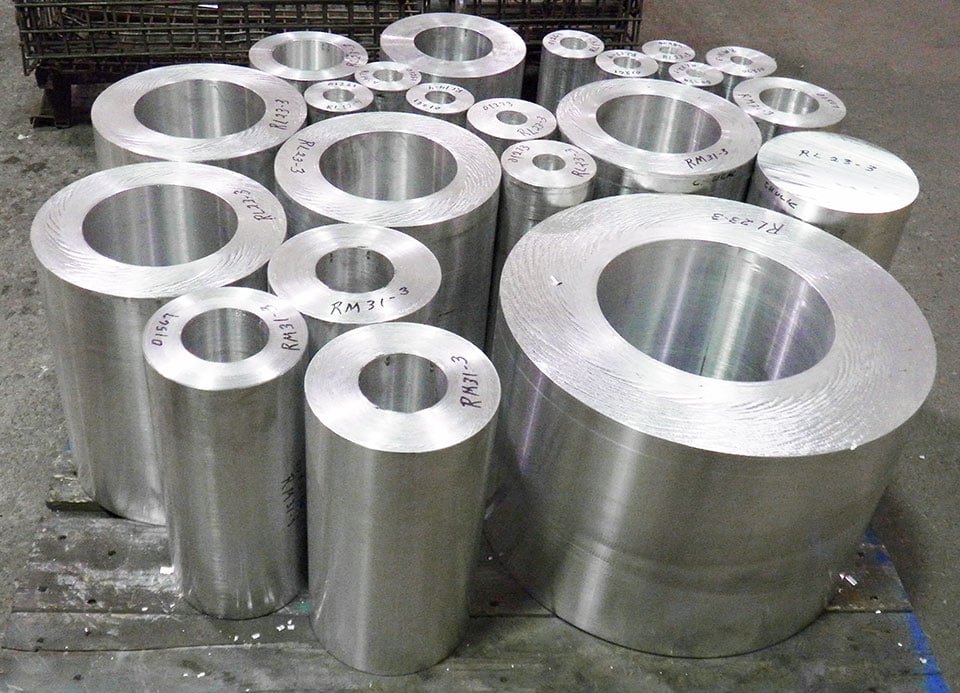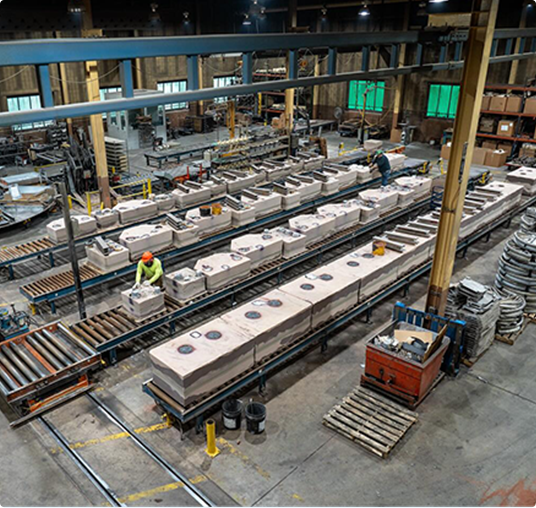Why Aluminum Castings are crucial for industrial applications
Revealing the Perks and Practical Use Light Weight Aluminum Castings in Today's Market
Aluminum spreadings have actually become significantly appropriate in numerous industries due to their distinct features. Their lightweight nature and resistance to deterioration make them appropriate for requiring applications. Furthermore, the premium strength-to-weight ratio supplies considerable benefits in design and production. As industries proceed to discover their possibility, the full extent of aluminum castings' advantages and applications remains to be fully revealed. What lies ahead for this functional material?
The Lightweight Benefit of Aluminum Castings
Numerous materials are utilized in production, aluminum castings stand out mainly due to their lightweight buildings. This characteristic makes aluminum spreadings an attractive selection for numerous industries, particularly in aerospace and vehicle applications, where weight reduction is important for enhancing gas effectiveness and efficiency. The light-weight nature of light weight aluminum permits manufacturers to create components that are simpler to mount and manage, eventually reducing labor expenses.
In addition, the ability to create complicated shapes without considerable weight penalties enables designers to innovate while keeping architectural honesty. Light weight aluminum castings can efficiently replace larger materials, bring about significant savings in shipping and operational prices. Their light-weight advantage also adds to boosted item durability, as lighter components frequently bring about lowered deterioration on machinery. On the whole, the light-weight properties of aluminum spreadings offer producers with an affordable side, fostering innovations in product design and performance across various fields.

Outstanding Deterioration Resistance
Light weight aluminum spreadings have a natural resistance to oxidation, which considerably boosts their long life in various atmospheres. This fundamental home not only contributes to their longevity however additionally straightens with the light-weight benefit that light weight aluminum offers. Consequently, aluminum castings are progressively identified for their extraordinary rust resistance in numerous applications.

Naturally Immune to Oxidation
One of the standout features of aluminum spreadings is their remarkable deterioration resistance, which stems from a natural oxidation process. When subjected to air, light weight aluminum responds to create a thin, protective layer of aluminum oxide. This layer serves as an obstacle against further oxidation and safeguards the underlying steel from destructive elements such as dampness and salts. Unlike other steels, this oxide layer is self-repairing; if harmed, it quickly reforms when subjected to air. This distinct residential property boosts the longevity of light weight aluminum spreadings in numerous settings, making them excellent for applications in sectors such as aerospace, automobile, and marine. Subsequently, the all-natural resistance to oxidation substantially decreases upkeep expenses and raises the integrity of aluminum castings in demanding problems.
Light-weight Resilience Benefit
The lightweight nature of light weight aluminum castings contributes greatly to their toughness, making them a helpful option in different sectors. This extraordinary toughness is mainly associated to light weight aluminum's innate resistance to rust, which is enhanced better with anodizing and other surface area treatments. Unlike lots of metals, aluminum does not corrosion; instead, it develops a safety oxide layer that shields it from environmental damage. This residential property is especially advantageous in sectors such as automotive and aerospace, where weight reduction is critical without compromising strength. Additionally, the longevity of aluminum spreadings reduces upkeep expenses and replacements, providing economic advantages with time. Their light-weight durability and corrosion resistance placement aluminum spreadings as a premium material for contemporary manufacturing applications.

Superior Strength-to-Weight Proportion
An amazing quality of light weight aluminum castings is their superior strength-to-weight ratio, that makes them extremely desirable in different applications. This inherent building allows aluminum castings to withstand significant anxiety while staying light-weight, an important consider markets such as aerospace, automotive, and manufacturing. Designers frequently favor light weight aluminum spreadings for parts that require both durability and decreased weight, enhancing gas efficiency and performance.
The high strength-to-weight proportion likewise helps with the layout of detailed shapes and structures, making aluminum spreadings versatile for complex applications. The ability to maintain structural integrity under tough problems assurances longevity and integrity in items, from airplane frames to automotive parts. This benefit adds to the growing trend of using light weight aluminum castings in cutting-edge designs, eventually bring about improved performance and performance across diverse industries. As a result, the exceptional strength-to-weight proportion of aluminum spreadings positions them as a critical product in modern engineering and production.
Cost-Effectiveness in Manufacturing
Cost-effectiveness in light weight aluminum casting manufacturing is primarily accomplished via decreased material waste and efficient manufacturing processes. By enhancing styles and utilizing sophisticated methods, suppliers can decrease excess material usage while maintaining quality criteria. This method not only decreases production expenses however likewise contributes to more sustainable practices within the sector.
Minimized Product Waste
Minimizing material waste in aluminum spreading processes considerably enhances production effectiveness. By maximizing the layout and production techniques, companies can decrease excess scrap and enhance source application. This decrease in waste not just decreases material costs however likewise adds to a more lasting production version. The ability to recycle aluminum further supports cost-effectiveness, enabling manufacturers to recover and reuse materials without compromising quality. As the industry significantly focuses on sustainability, decreased product waste straightens with ecological goals while at the same time improving earnings. Eventually, efficient use resources enhances the competitive position of companies in the market, making aluminum castings a beneficial option in numerous applications. The critical technique to reducing waste mirrors a commitment to both economic and environmental duty.
Reliable Manufacturing Processes
While conventional production processes can incur substantial costs, light weight aluminum casting supplies a much more efficient choice that enhances overall manufacturing earnings. This method decreases material waste and permits specific control over the manufacturing process, causing decreased labor and functional costs. The capacity to produce intricate shapes with less steps additionally streamlines manufacturing, adding to much shorter preparations. Additionally, aluminum's lightweight nature and excellent thermal conductivity allow for energy financial savings during manufacturing and in the last application. By utilizing contemporary spreading modern technologies, producers can accomplish greater throughput without giving up high quality. Light weight aluminum casting stands out as a cost-efficient service, making it an attractive option for organizations aiming to enhance their production procedures in today's affordable market.
Convenience Across Industries
Light weight aluminum spreadings show impressive versatility across numerous markets, as they can be customized to meet specific demands and applications. In the automobile sector, aluminum castings are used in engine blocks, transmission housings, and wheels, offering lightweight yet durable services that improve fuel efficiency. The aerospace industry also benefits from light weight aluminum spreadings, utilizing them in structural elements and engine parts due to their strength-to-weight ratio.
In the durable goods industry, producers utilize aluminum spreadings for products ranging from pots and pans to furniture, providing both visual allure and functionality. The electronics industry makes use of light weight aluminum castings for real estates and warmth sinks, making sure reliable thermal management. In addition, the building and construction sector leverages light weight aluminum spreadings for structural parts and architectural components, enhancing longevity and style flexibility. This wide applicability highlights aluminum spreadings as a crucial source, meeting the varied requirements of various markets while preserving high performance and reliability.
Sustainability and Ecological Effect
As industries significantly prioritize lasting practices, aluminum castings emerge as an environmentally friendly selection because of their recyclability and low environmental impact. Aluminum is among one of the most recycled materials around the world, with the capability to be repurposed multiple times without destruction of quality. This particular greatly minimizes the demand for resources and energy usage connected with primary light weight aluminum manufacturing, which is energy-intensive.
In addition, light websites weight aluminum castings contribute to light-weight designs, causing sustain effectiveness in transport applications such as automotive and aerospace sectors. Their sturdiness and resistance to corrosion prolong item lifespans, even more lessening waste and source use with time. Many makers are taking on liable sourcing and environmentally friendly production methods, boosting the sustainability of light weight aluminum spreading procedures. On the whole, light weight aluminum spreadings stand for a practical solution for companies intending to decrease their ecological influence while achieving efficiency and performance.
Innovations in Light Weight Aluminum Casting Technologies
Recent innovations in light weight aluminum casting technologies have substantially improved the effectiveness and quality of manufacturing processes. Developments such as 3D printing and progressed mold-making methods have made it possible for makers to produce intricate designs with decreased product waste. This change not just improves the accuracy of cast parts however also reduces preparations, enabling for rapid prototyping and faster market entrance.
The unification of advanced computer system simulations aids in anticipating potential flaws throughout spreading, leading to higher-quality results. Using light-weight alloys has likewise added to the development of more powerful, extra resilient items, accommodating markets varying from automobile to aerospace
Additionally, automated spreading procedures have emerged, decreasing human error and boosting manufacturing speed. Collectively, these technologies are changing the aluminum casting landscape, driving higher competition and sustainability in production. As industries continue to progress, these modern technologies will certainly play an important function in conference future needs for performance and quality.
Often Asked Concerns
Just How Do Aluminum Castings Compare to Various Other Metals in Terms of Thermal Conductivity?
Light weight aluminum spreadings display exceptional thermal conductivity contrasted to several metals, such as steel and iron - Aluminum Castings. Their lightweight nature and efficient heat distribution make them ideal for applications calling for reliable thermal monitoring in numerous sectors
What Are the Usual Problems Located in Light Weight Aluminum Castings?
Usual flaws in light weight aluminum castings include porosity, shrinkage, inclusions, and surface irregularities. These issues typically occur from incorrect cooling prices, poor mold and mildew style, or contaminations, affecting the overall quality and efficiency of the final item.
Can Light Weight Aluminum Castings Be Recycled, and How?
Aluminum castings can be reused properly. The procedure entails gathering, melting, and reforming description the aluminum, which decreases waste and conserves resources. This reusing adds to sustainability while preserving the material's residential or commercial properties for future use.
What Are the Typical Lead Times for Light Weight Aluminum Casting Manufacturing?
Commonly, preparations for aluminum spreading production range from 2 to six weeks, depending on variables such as complexity, tooling requirements, and manufacturing volume. Efficiency can enhance with recognized supplier partnerships and optimized production processes.
How Does the Surface Finish Affect Light Weight Aluminum Casting Performance?
The surface area finish substantially impacts light weight aluminum spreading performance by affecting corrosion resistance, visual high quality, and friction attributes. A smoother finish improves resilience and capability, while a rougher texture can enhance attachment for succeeding finishes or therapies.
Numerous materials are used in manufacturing, aluminum castings stand out largely due to their lightweight properties. When subjected to air, aluminum reacts to form a thin, safety layer of light weight aluminum oxide. Cost-effectiveness in aluminum casting manufacturing is largely accomplished via minimized material learn the facts here now waste and efficient production processes. Minimizing product waste in light weight aluminum casting processes considerably improves manufacturing efficiency. Eventually, effective usage of raw products reinforces the competitive position of companies in the market, making light weight aluminum spreadings a desirable option in various applications.